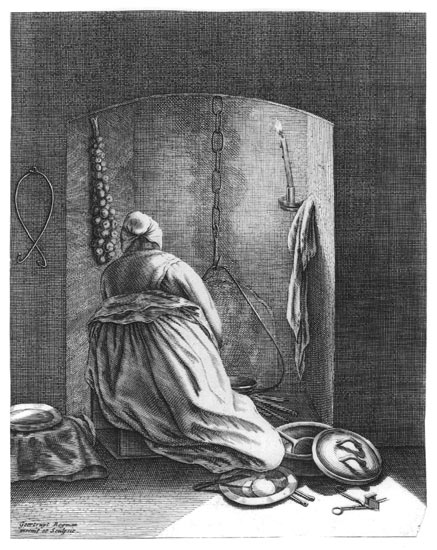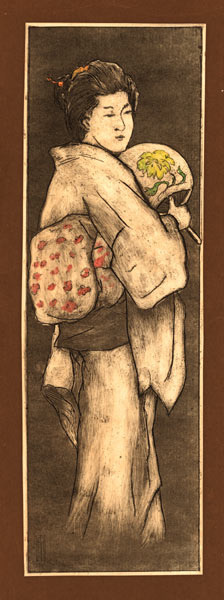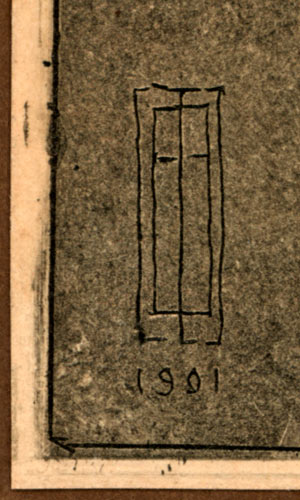The
Feminine Touch
A Selection of Prints currently
in stock by Women Artists
This
link: Prints
by Women Artists 01, will allow you
to view the selected prints from the
previous series of Prints by Women Artists |
|
See
also :
Click
on a thumbnail (left)
to link directly with the entry for that
print, or scroll down to view all this month's
selection. Images are not at very high resolution.
Other
prints by women artists appear extensively
throughout the website, many of which are
still available for purchase.
If
you require further information on any
print featured here, please contact
us. When
a print has been sold it will be marked
as Sold.
|
|
|
|
 |
|
GEERTRUYDT ROGHMAN
Born Amsterdam 1625
Geertruydt
Roghman came from a well-known family of
artists but few facts are known about her
life.
Her
father, and presumably her teacher, was the
engraver Hendrik Lambertz Roghman. Her mother
was the sister of the painter and etcher
Roelandt Savery. Geertruydt’s brother Roelant and sister Magdalena were also engravers.
Geertruydt engraved 23 plates , mainly in conjunction with her brother or after his imaginary mountain landscape paintings, or other Dutch topographical drawings.
However,
she also engraved a series of five original
plates, amongst the earliest original (as
opposed to interpretive) prints by a woman.
They are equally exceptional in being on the
theme of female occupations. Though domestic
interiors with women at work were common
in Dutch painting of the time, and as prints
in illustrations for almanacs and popular
books of poetry and proverbs, as independent
plates the imagery is unusual.
The
five subjects show women sewing, spinning,
ruffling, cooking and cleaning plate. Each
plate shows a strong interest in light effects,
either slanting diagonal shafts of daylight,
candlelight, firelight or ‘contre-jour’ – the figure seen against daylight coming in from a window.
The compositions are simple but strong and effective, with well-rounded figures and beautifully observed still life details of domestic articles.
Woman
cooking
Hollstein 4
205 x 162 mm
Original
engraving, c1647.
Only state.
Plate 3 of
the series of five women’s occupations.
The plate signed. A fine impression.
Trimmed to or fractionally within the image on three sides
and 6mm within the image at the top. The bottom right corner cut away,
hence lacking the plate number (3).
Otherwise good condition.
Watermark: Fool’s Cap.
Sold
Return to top ^ |
|
|
|
 |
|

Detail showing 'monogram' |
|
|
BERTHA EVELYN JAQUES (Née Clausen)
Covington, Ohio 1863 – 1941 Chicago
The
wife of a Chicago surgeon, and already a
painter, Bertha Jaques discovered etching
at the Chicago World Columbian Exposition
in 1893. Overwhelmed by the display of etchings
by French artists she taught herself the
technique with improvised tools fashioned
by her husband from surgical implements,
and had mastered it by 1897. Ultimately she
etched over 400 plates and in 1910 she was
instrumental in founding the Chicago Society
of Etchers.
Jaques
read about Helen Hyde (1868-1919)’s work in The
International Studio magazine in 1898, before Hyde went to Japan, and wrote to her saying she did not believe in adding colour to etchings and asking for her comment. Hyde sent her two of her colour etchings and they became friends, though they met in person only four years later when Hyde, then resident in Japan, made a return visit to the United States, 1901-1902, and visited Jaques in Chicago.
Bertha
sometimes printed etching plates for Helen
Hyde and in the Japanese way of divided ‘labour’ may have etched plates to Hyde’s design. Such would appear to be the case with Toyo
San.
Toyo
San (Miss Chrysanthemum)
288 x 90 mm
Colour
etching, 1901, in collaboration with Helen
Hyde.
The
plate signed with an (invented?) ‘Japanese’ monogram* and dated. The plate selectively wiped; the colour either à la poupée or hand-applied. Trimmed to narrow margins and mounted onto thin brown card, probably by the artist.
Sold
Japan
is known as the Land of the Chrysanthemum.
*Bertha
Jaques herself did not usually etch a signature
in her plates. Helen Hyde’s plates are signed with her initials HH.
Return to top ^ |
|
|
|
|
|
SUZANNE VALADON
Bessines, Haut Vienne 1865 – 1938 Paris
Suzanne Valadon is an exception among women artists working at this period in
Paris, in not coming from the professional middle and upper classes. She
was the illegitimate daughter of a working class mother and began her career,
aged fifteen, as a circus acrobat. After an accident she took instead to
modelling for artists, who included Puvis de Chavannes, Lautrec, Renoir,
and Degas among others, and developed an artistic inclination of her own.
It was Degas who taught her soft-ground etching in 1895. She progressed to
hard-ground etching in 1904 and to drypoint in 1908.
After
1910 she concentrated almost exclusively
on painting and it was only in 1932, when
she had established a reputation as an artist,
that Valadon arranged to print editions from
her etching plates, for which they were steel
faced*.
She
produced around thirty plates in total, generally
intimate domestic scenes of women and children,
based on studies of her family. A friend
of Picasso in his ‘blue’ period, she absorbed elements of his style as well as that of the Impressionists for whom she had modelled.
Marie
au Tub s’épongeant
Marie in the bath
tub, sponging herself
Petrides 13
165 x 220 mm
Original
drypoint, 1908.
The plate signed and dated
(in reverse).
A
superb rare early proof impression, rich
in burr. Signed in pencil. Printed in sepia
on laid paper. A printing crease in the lower
margin, other small marginal defects.
Sold
A
study of Marie-Lucienne, Valadon’s niece.
*Most
of the plates responded well to this treatment,
but that of Marie au Tub s’épongeant was adversely affected, gaining areas similar to foulbiting and losing most of the burr and all the velvety depth and richness of line that the plate reveals, as above, before steelfacing.
Return
to top ^ |
|
|
|
|
|
MARGARET KEMP-WELCH A.R.E.
Exhibiting from 1898. Died 1968 Throwleigh, Devon
A
landscape and portrait painter, and landscape
etcher, particularly in aquatint, Margaret
Kemp-Welch was born in London c1880. She
was a cousin of the painter Lucy Kemp-Welch.
Margaret too first studied at Bushey School
of Art, about 1891, under Hubert von Herkomer,
before attending the Royal College of Art
where Frank Short was Professor of Engraving.
She
was elected an Associate of the Royal Society
of Painter-Etchers in 1901 and was an active
exhibitor with the Society into the 1930’s, showing over a 100 etchings. She also exhibited regularly at the Ridley Art Club* and occasionally at the Royal Academy.
She
taught art at Clapham High School. After
her retirement she moved to Devon in the
1940’s.
Gannets
200 x 250 mm
Original
etching. Signed in pencil.
On cream wovepaper.
£100
*An
exhibiting society, founded by students of
the painter Matthew Ridley, that held shows
at the Grafton Galleries from 1889 to c1919.
Return to top ^ |
|
|
|
|
|
BEATRICE DEAN DARBYSHIRE
Perth, Australia 1901 – 1988 Perth
Beatrice
Darbyshire as a young girl attended Saturday
morning classes, and again after boarding
school, studied full-time with Henri van
Raalte in Perth. In 1924, on van Rallte’s
advice she travelled to England.
After
one term at the Slade School of Art she joined
the Engraving School of the Royal College
of Art, where her tutors were Malcolm Osborne
and Job Nixon.
After
graduating in 1927 she returned to Perth,
and had an etching press made to the same
specifications as van Raalte’s press.
She
exhibited regularly until 1939 but suddenly
abandoned etching in 1940 to go in a totally
different direction, joining the Women’s League of Health.
Her
early work was rediscovered in 1979 and exhibited
again in national museums.
Landscape
at Balingup ?
175 x 243 mm
Original
etching with aquatint, c1924-27.
A
dedicated proof (To A.E. Dean). Signed in
pencil. Printed on cream Milbourne watermarked
wove paper.
Sold
The
young Beatrice Darbyshire frequently went
on visits to her aunt Jean Lukis at Netherton
Farm, Balingup. The tall trees of the landscape
around the Australian farmstead would inspire
some of her best work at the Royal College
of Art.
While
a student at the R.C.A. two of her drypoints,
In the Blackwood Country and The
Cowshed, Balingup were chosen for the
British Empire Exhibition at Wembley in 1924
and 1925 and both won medals.
Return to top ^ |
|
|
|
|
|
MONICA POOLE R.E.,
S.W.E.
Canterbury 1921 – 2003
“If I have a message, it is simply Look
at this”
(Monica Poole)
Teasels
350 x 208
Original
wood engraving. Signed in pencil, entitled
and numbered 37/50.
On thin japan paper.
Sold
Return to top ^ |
|
|
|
|
|
ANNETTE LEWIN
Born New York 1933
Annette
Lewin moved first to Israel in 1960, where
she worked as an illustrator of children’s
books and for the health service, before
settling in London. In 1973 she attended
the Camden Institute, and subsequently with
fellow printmaking students of Peter Freeth
at the Institute, she founded Camden Printmakers.
The members of the group are all interested in the Art for Hospitals movement
and Annette Lewin works as a volunteer at
the Royal Free in Hampstead placing art works
in communal spaces.
Guitar
180 x 152 mm
Colour
monotype. Signed in pencil.
The
unique impression, and numbered 1/1. Printed
on stiff white wove paper.
Sold
Return to top
^ |
|
|
|
|
|
|
|